Centos7.6搭建ELK日志分析系统
一、前言:
日志分析是我们运维解决系统故障、发现问题的主要手段。为了可以集中管理多台服务器的日志记录,开源实时日志分析ELK平台应用而生,ELK由Elasticsearch、Logstash和Kibana三个开源工具组成,这三个工具可以分别部署在不同的服务器上,并且相互关联,不过需要收集哪台服务器的日志,就须在该服务器上部署Logstash。更多相关介绍,请移步至Elastic官网。
ELK的工作原理如下(懂得其中原理,才可部署一个高可用的ELK平台):
Logstash收集APPServer(应用服务器)产生的log,并存放到Elasticsearch群集中,而Kibana则从Elasticsearch群集中查询数据生成图表,在返回给browser(浏览器)。简单来说,进行日志处理分析,一般需要以下几个步骤:
1、Logstash将日志进行集中化管理。
2、Logstash将日志进行集中化管理。
3、Elasticsearch对格式化后的数据进行索引和存储。
4、Kibana对前端数据的展示。
二、搭建ELK平台:
| 操作系统 | 主机名/IP地址 | 软件安装 |
| Centos 7.6 | lb01/192.168.11.61 |
Elasticsearch Kibana |
| Centos 7.6 | lb02/192.168.11.62 | Elasticsearch |
| Centos 7.6 | lb/192.168.11.60 | Logstash/apache/nginx |
| Centos 7.6 | lb03/192.168.11.63 | filebeat |
所有节点关闭防火墙、Selinux、配置java环境变量;
lb01 节点:
[root@lb01 ~]# hostname #查看主机名 lb01 [root@lb01 ~]# cat /etc/hosts #更改本地解析文件,添加如下两行 127.0.0.1 localhost localhost.localdomain localhost4 localhost4.localdomain4 ::1 localhost localhost.localdomain localhost6 localhost6.localdomain6 192.168.11.61 lb01 # 添加 192.168.11.62 lb02 # 添加 [root@lb01 ~]# java -version #检查Java环境 openjdk version "1.8.0_181" OpenJDK Runtime Environment (build 1.8.0_181-b13) OpenJDK 64-Bit Server VM (build 25.181-b13, mixed mode)
lb01 节点:
[root@lb02 ~]# hostname #查看主机名 lb02 [root@lb02 ~]# cat /etc/hosts #更改本地解析文件,添加如下两行 127.0.0.1 localhost localhost.localdomain localhost4 localhost4.localdomain4 ::1 localhost localhost.localdomain localhost6 localhost6.localdomain6 192.168.11.61 lb01 # 添加 192.168.11.62 lb02 # 添加 [root@lb02 ~]# java -version #检查Java环境 openjdk version "1.8.0_181" OpenJDK Runtime Environment (build 1.8.0_181-b13) OpenJDK 64-Bit Server VM (build 25.181-b13, mixed mode)
二、安装Elasticsearch
lb01 节点配置:
[root@lb01 ~]# cd /usr/local/ [root@lb01 local]# rpm -ivh elasticsearch-6.4.0.rpm [root@lb01 local]# vim /etc/elasticsearch/elasticsearch.yml #修改如下,注意删除注释符号 cluster.name: my-elk-cluster #群集名字 node.name: lb01 #节点名字 path.data: /data/elk_data #数据存放路径 path.logs: /var/log/elasticsearch/ #日志存放路径 bootstrap.memory_lock: false #在启动的时候不锁定内存 network.host: 0.0.0.0 #提供服务绑定的IP地址,0.0.0.0代表所有地址 http.port: 9200 #侦听端口 discovery.zen.ping.unicast.hosts: ["lb01", "lb02"] #群集发现通过单播实现 [root@lb01 local]# mkdir -p /data/elk_data #创建数据存放目录 [root@lb01 local]# chown -R elasticsearch:elasticsearch /data/elk_data/ #更改属主及属组 [root@lb01 local]# chown -R elasticsearch:elasticsearch /var/log/elasticsearch/ [root@lb01 local]# systemctl start elasticsearch.service #启动服务 [root@lb01 local]# netstat -tunlp | grep java tcp6 0 0 :::9200 :::* LISTEN 19296/java tcp6 0 0 :::9300 :::* LISTEN 19296/java
lb02 节点配置:
[root@lb02 ~]# cd /usr/local/ [root@lb02 local]# rpm -ivh elasticsearch-6.4.0.rpm [root@lb02 local]# vim /etc/elasticsearch/elasticsearch.yml #修改如下,注意删除注释符号 cluster.name: my-elk-cluster #群集名字 node.name: lb02 #节点名字 path.data: /data/elk_data #数据存放路径 path.logs: /var/log/elasticsearch/ #日志存放路径 bootstrap.memory_lock: false #在启动的时候不锁定内存 network.host: 0.0.0.0 #提供服务绑定的IP地址,0.0.0.0代表所有地址 http.port: 9200 #侦听端口 discovery.zen.ping.unicast.hosts: ["lb01", "lb02"] #群集发现通过单播实现 [root@lb02 local]# mkdir -p /data/elk_data #创建数据存放目录 [root@lb02 local]# chown -R elasticsearch:elasticsearch /data/elk_data/ #更改属主及属组 [root@lb02 local]# chown -R elasticsearch:elasticsearch /var/log/elasticsearch/ [root@lb02 local]# systemctl start elasticsearch.service #启动服务 [root@lb02 local]# netstat -tunlp | grep java tcp6 0 0 :::9200 :::* LISTEN 19296/java tcp6 0 0 :::9300 :::* LISTEN 19296/java
3、查看节点信息:
lb01节点信息:
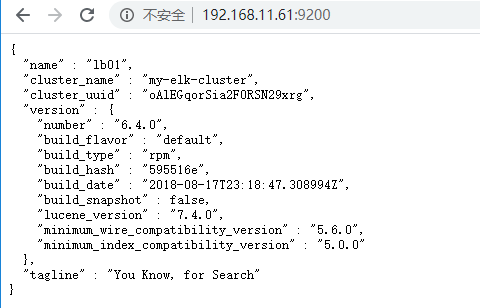
lb02节点信息:
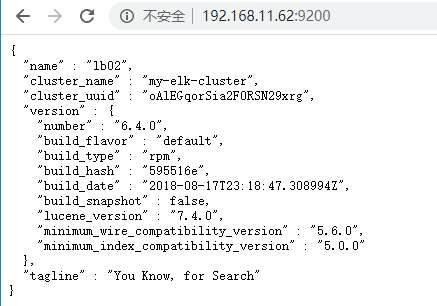
访问http://192.168.11.61:9200/_cluster/health?pretty 查看群集的健康状态:
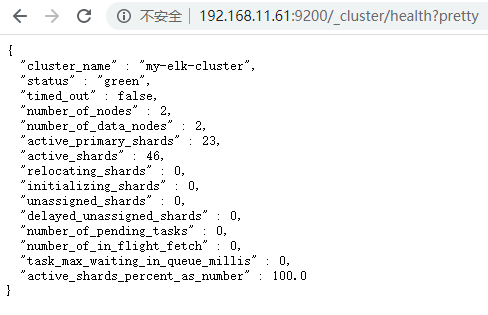
访问http://192.168.11.61:9200/_cluster/state?pretty 查看群集的状态信息:

通过以上方式查看群集状体对我们显示的并不友好,可以通过安装Elasticsearch-head插件,可以更方便的管理群集:
在lb01安装Elasticsearch-head插件:
方法一、
导入node-v8.2.1.tar.gz phantomjs-2.1.1-linux-x86_64.tar.bz2 安装包
安装node:
tar zxvf node-v8.2.1.tar.gz
cd node-v8.2.1/
./configure && make && make install
安装phantomjs:
tar jxvf phantomjs-2.1.1-linux-x86_64.tar.bz2
cd phantomjs-2.1.1-linux-x86_64/bin/
cp phantomjs /usr/local/bin/
导入es-head程序包并解压:
unzip master.zip –d /usr/local/
cd elasticsearch-head/
npm install
npm run start &
查看端口状态:(端口默认9100)
netstat –anpt | grep 9100
方法二、(本次采用此方法)
git clone git://github.com/mobz/elasticsearch-head.git
cd elasticsearch-head
npm install
npm run start &
netstat –anpt | grep 9100
方法三、
拉取镜像: docker push mobz/elasticsearch-head:5
启动镜像: docker run -p 9100:9100 mobz/elasticsearch-head:5
web访问测试: http://IP:9100
[root@lb01 local]# cd /usr/local/elasticsearch-head [root@lb01 elasticsearch-head]# vim /etc/elasticsearch/elasticsearch.yml #编辑主配置文件,在任意位置添加如下两行: http.cors.enabled: true #添加该行,开启跨域访问支持 http.cors.allow-origin: "*" #添加该行,跨域访问允许的域名地址 [root@node1 elasticsearch-head]# systemctl restart elasticsearch #重启服务 [root@node1 elasticsearch-head]# npm run start & #设置服务后台启动,如果前台启动,一旦关闭中断,服务也将关闭。 #并且启动服务时,必须在解压后的elasticsearch-head下启动服务, #进程会读取该目录下的一个文件,否则可能启动失败。 [root@lb01 elasticsearch-head]# netstat -tunlp | grep 9100 tcp 0 0 0.0.0.0:9100 0.0.0.0:* LISTEN 25339/grunt
现在就可以通过浏览器访问http://192.168.1.1:9100 去查看群集信息了,如下:
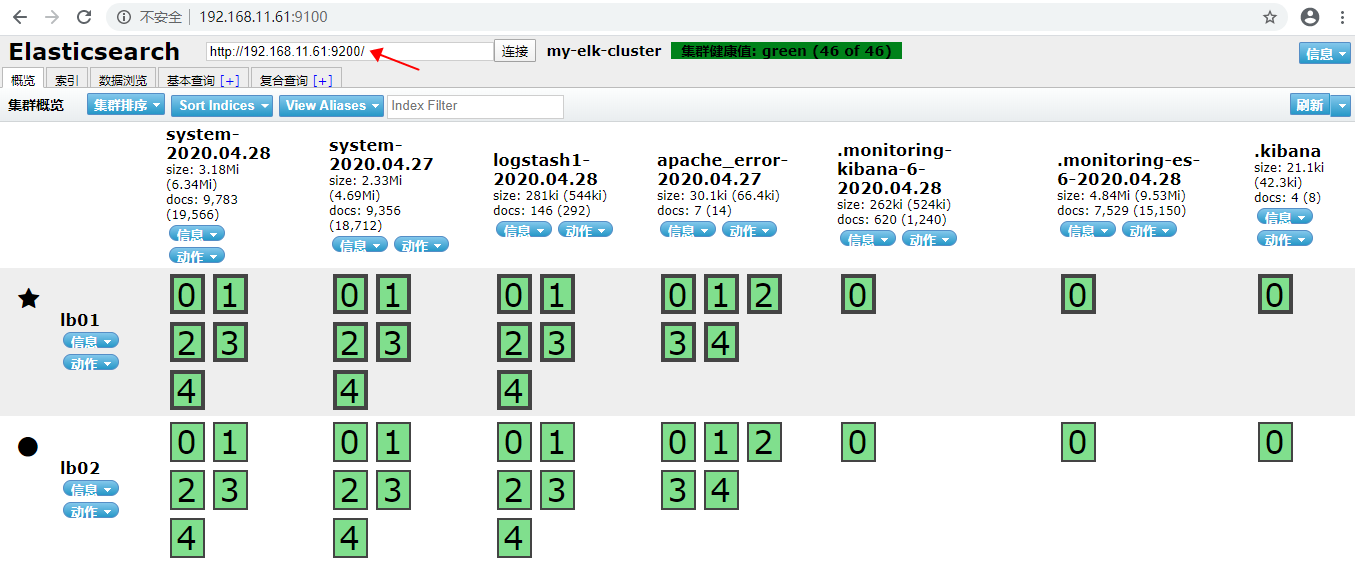
4、安装Kibana(可单独安装在一台服务器上,此处安装在lb01节点上面):
[root@lb01 local]# rpm -ivh kibana-6.4.0-x86_64.rpm [root@lb01 local]# systemctl enable kibana [root@lb01 local]# vim /etc/kibana/kibana.yml server.port: 5601 #Kibana打开的端口 server.host: "0.0.0.0" #Kibana侦听的地址,0.0.0.0代表该主机上的所有地址 elasticsearch.url: "http://192.168.1.1:9200" #和Elasticsearch建立连接 kibana.index: ".kibana" #在Elasticsearch中添加.kibana索引 [root@lb01 local]# systemctl start kibana #启动Kibana
5、配置apache、logstash服务
[root@lb ~]# yum -y install httpd [root@lb ~]# systemctl start httpd [root@lb ~]# cd /usr/local [root@lb local]# rpm -ivh logstash-6.4.0.rpm [root@lb ~]# systemctl enable logstash.service [root@lb ~]# cd /etc/logstash/conf.d/ #切换至指定路径 [root@lb conf.d]# vim apache_log.conf #编辑采集apache日志文件和系统日志 #以下就以系统日志为例做解释,其余的照着来就行,格式都差不多 input { file{ path => "/var/log/messages" #指定要收集的日志文件 type => "system" #指定类型为system,可以自定义,type值和output{ } 中的type对应即可 start_position => "beginning" #从开始处收集 } file{ path => "/etc/httpd/logs/access_log" type => "access" start_position => "beginning" } file{ path => "/etc/httpd/logs/error_log" type => "error" start_position => "beginning" } } output { if [type] == "system" { #如果type为system, elasticsearch { #就输出到Elasticsearch服务器 hosts => ["192.168.11.61:9200"] #Elasticsearch监听地址及端口 index => "system-%{+YYYY.MM.dd}" #指定索引格式 } } if [type] == "access" { elasticsearch { hosts => ["192.168.11.61:9200"] index => "apache_access-%{+YYYY.MM.dd}" } } if [type] == "error" { elasticsearch { hosts => ["192.168.11.61:9200"] index => "apache_error-%{+YYYY.MM.dd}" } } } #写完保存退出即可。 [root@lb conf.d]# chmod o+r /var/log/messages #赋予该目录其他人的读权限 [root@lb conf.d]# ln -s /usr/share/logstash/bin/logstash /usr/local/bin/ #创建命令软连接 [root@lb conf.d]# systemctl start logstash #启动服务 [root@lb conf.d]# logstash -f apache_log.conf & #指定刚才编写文件为Logstash的配置文件,并且在后台运行
6、创建索引:
1、通过浏览器访问 http://192.168.11.61:9100 查看索引是否创建:

关于索引,有几个很重要的概念:
索引:类似于关系数据库中的“库”;
Type(编写Logstash时指定的type):类似于关系数据库中的“表”;
刚才创建的索引,在我标记红框中,可以看到lb01和lb02对应的位置,都有绿色背景的0、1、2、3、4、5表示是该索引被分为了5个分片,其中因为在Logstash中指定的Elasticsearch服务器是lb01,所以lb01的分片是主分片,lb02会自动同步lb01的分片,lb02的分片为备份分片,称为副本,用来提供数据冗余及负载分担。默认情况下,Elasticsearch自动对索引请求进行负载分担。
现在访问http://192.168.11.61:5601 登录到Kibana,添加索引:

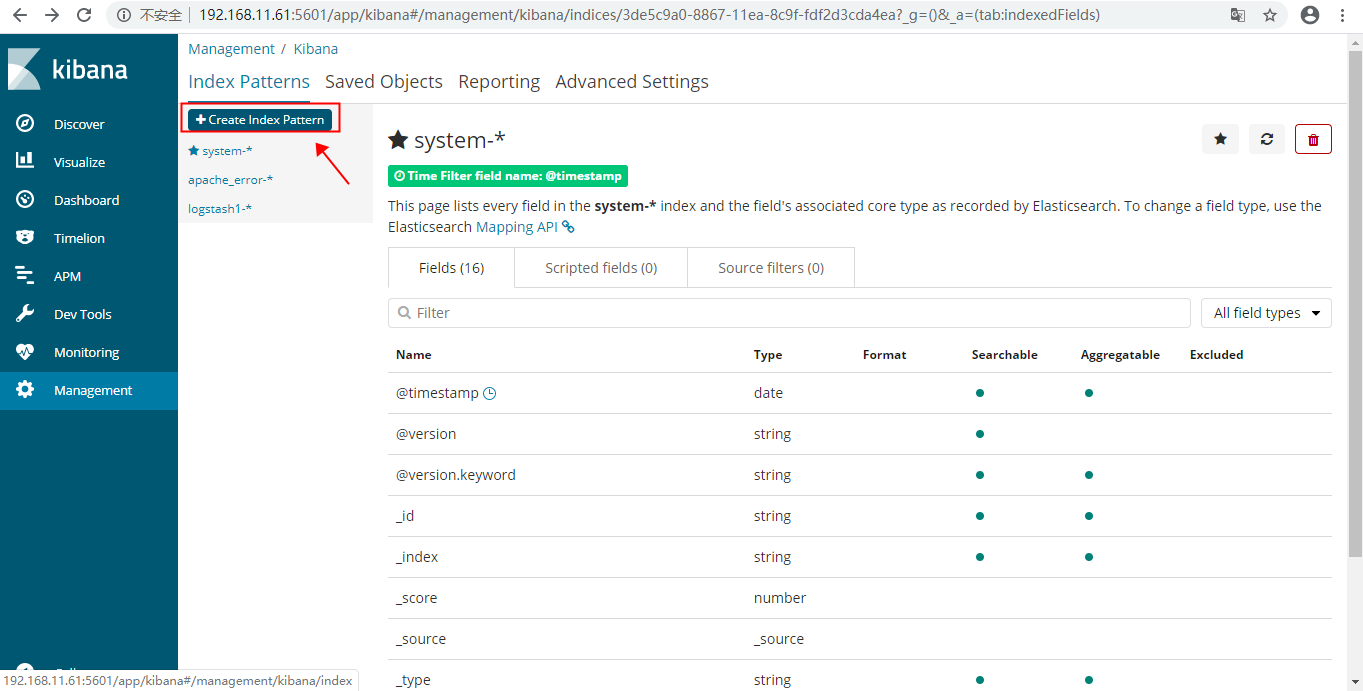
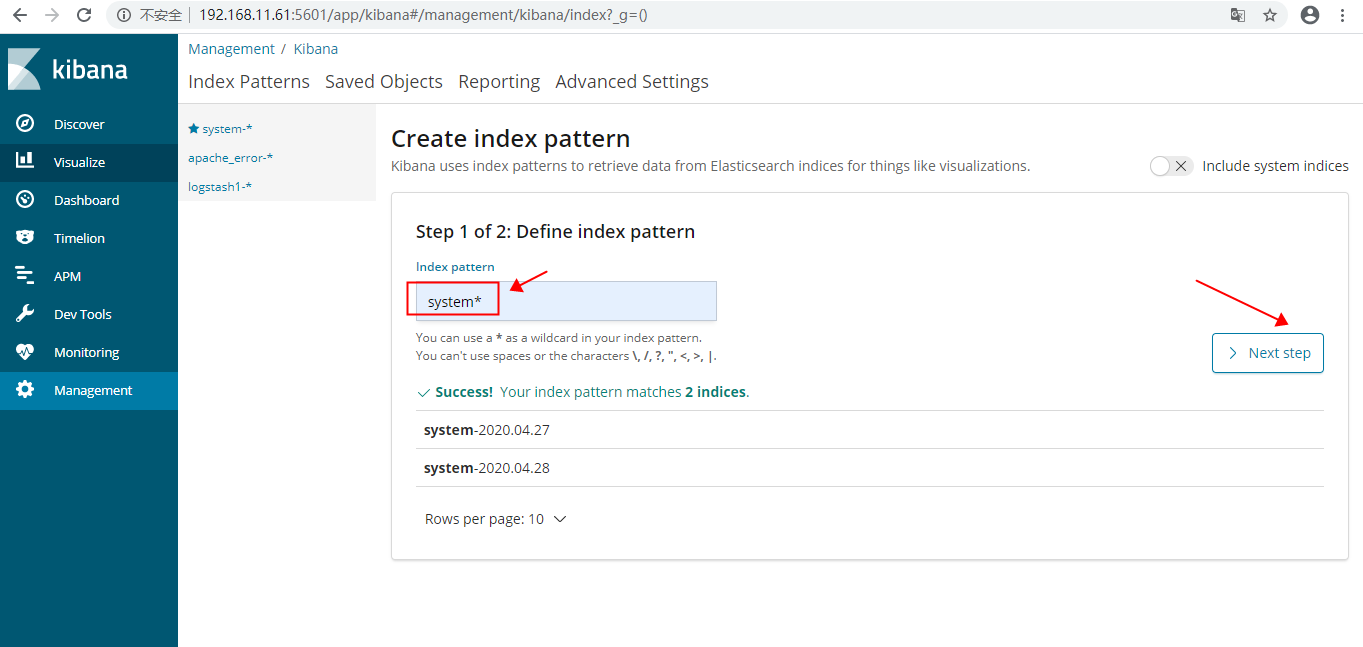

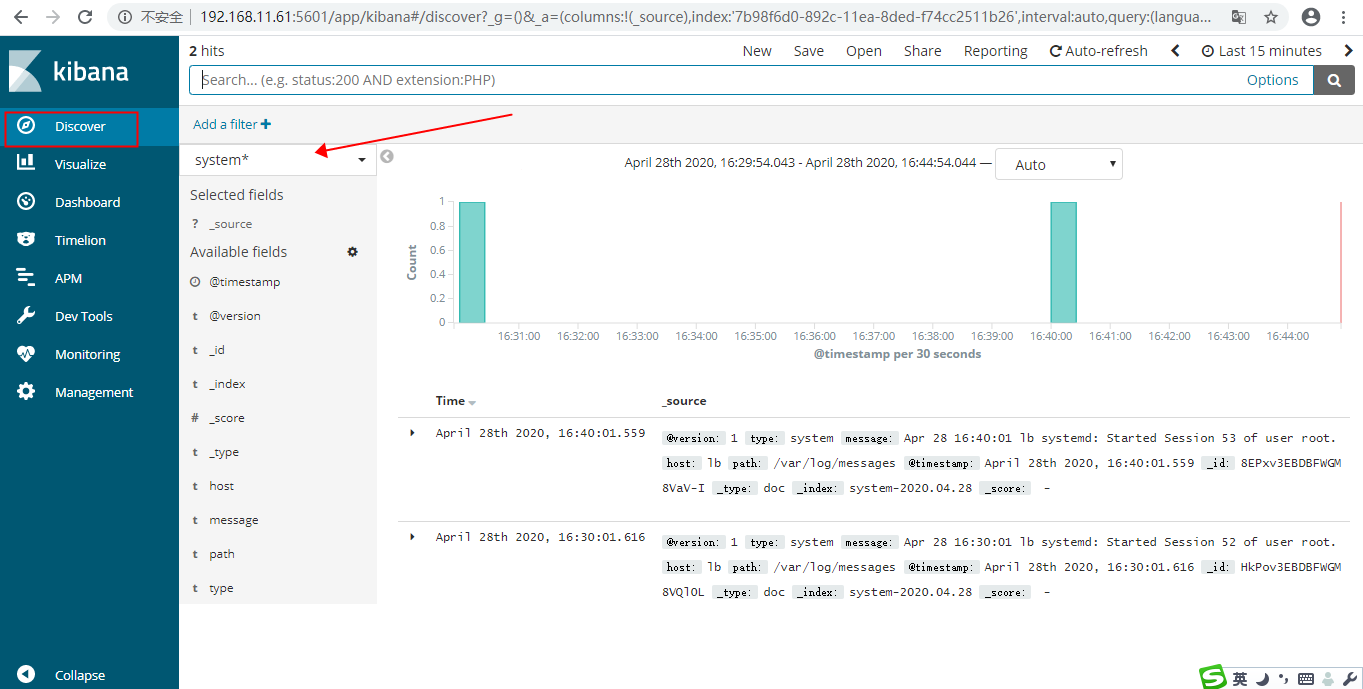
7、下面讲解如何收集syslog日志;
[root@lb ~]# vim /etc/logstash/conf.d/syslog.conf # 加入如下内容 input { # 定义日志源 syslog { type => "system-syslog" # 定义类型 port => 10514 # 定义监听端口 } } output { # 定义日志输出 stdout { codec => rubydebug # 将日志输出到当前的终端上显示 } }
检测配置文件是否有错:
[root@lb ~]# cd /etc/logstash/conf.d/ #进入安装目录 ./logstash --path.settings /etc/logstash/ -f /etc/logstash/conf.d/syslog.conf --config.test_and_exit Configuration OK # 为ok则代表配置文件没有问题 命令说明: --path.settings 用于指定logstash的配置文件所在的目录 -f 指定需要被检测的配置文件的路径 --config.test_and_exit 指定检测完之后就退出,不然就会直接启动了
配置kibana服务器的ip以及配置的监听端口:
[root@lb conf.d]# vim /etc/rsyslog.conf #### RULES #### *.* @192.168.11.61:10514
重启rsyslog,让配置生效:
[root@lb conf.d]# systemctl restart rsyslog
配置logstash
以上只是测试的配置,这一步我们需要重新改一下配置文件,让收集的日志信息输出到es服务器中,而不是当前终端:
[root@lb conf.d]# vim /etc/logstash/conf.d/syslog.conf input { # 定义日志源 syslog { type => "system-syslog" # 定义类型 port => 10514 # 定义监听端口 } } output { # 定义日志输出 elasticsearch { hosts => ["192.168.11.61:9200"] # 定义es服务器的ip index => "system-syslog-%{+YYYY.MM}" # 定义索引 } }
同样的需要检测配置文件有没有错:
[root@lb conf.d]# cd /etc/logstash/conf.d/ [root@lb conf.d]# ./logstash --path.settings /etc/logstash/ -f /etc/logstash/conf.d/syslog.conf --config.test_and_exit Configuration OK #表示通过检测正常
文件夹权限设置
[root@lb ~]# chown logstash /var/log/logstash/logstash-plain.log [root@lb ~]# chown -R logstash /var/lib/logstash/ [root@lb ~]# systemctl restart logstash
修改监听端口
[root@lb ~]# vim /etc/logstash/logstash.yml http.host: "192.168.11.60" #改成本机IP地址 [root@lb ~]# systemctl restart logstash [root@lb ~]# netstat -tunlp | egrep "10514|9600" tcp6 0 0 :::10514 :::* LISTEN 9556/java tcp6 0 0 192.168.11.60:9600 :::* LISTEN 9556/java udp 0 0 0.0.0.0:10514 0.0.0.0:* 9556/java
kibana上查看日志
logstash服务器的搭建之后,回到kibana服务器上查看日志,执行以下命令可以获取索引信息:
[root@lb01 ~]# curl '192.168.11.61:9200/_cat/indices?v' health status index green open .kibana -8Yy0C2GQWOgNQxnAdSlug 1 1 7 0 108.4kb 54.2kb green open system-2020.04.30 __WslC-GRxOxoXHFwuK5Mg 5 1 158982 0 29.9mb 14.9mb
如上,可以看到,在logstash配置文件中定义的system-syslog索引成功获取到了,证明配置没问题,logstash与es通信正常。
获取指定索引详细信息:
[root@lb01 ~]# curl -XGET '192.168.11.61:9200/system-syslog-2020.04?pretty'
如果日后需要删除索引的话,使用以下命令可以删除指定索引:
[root@lb01 ~]# curl -XDELETE 'localhost:9200/system-syslog-2020.04'
es与logstash能够正常通信后就可以去配置kibana了,浏览器访问192.168.77.128:5601,到kibana页面上配置索引:
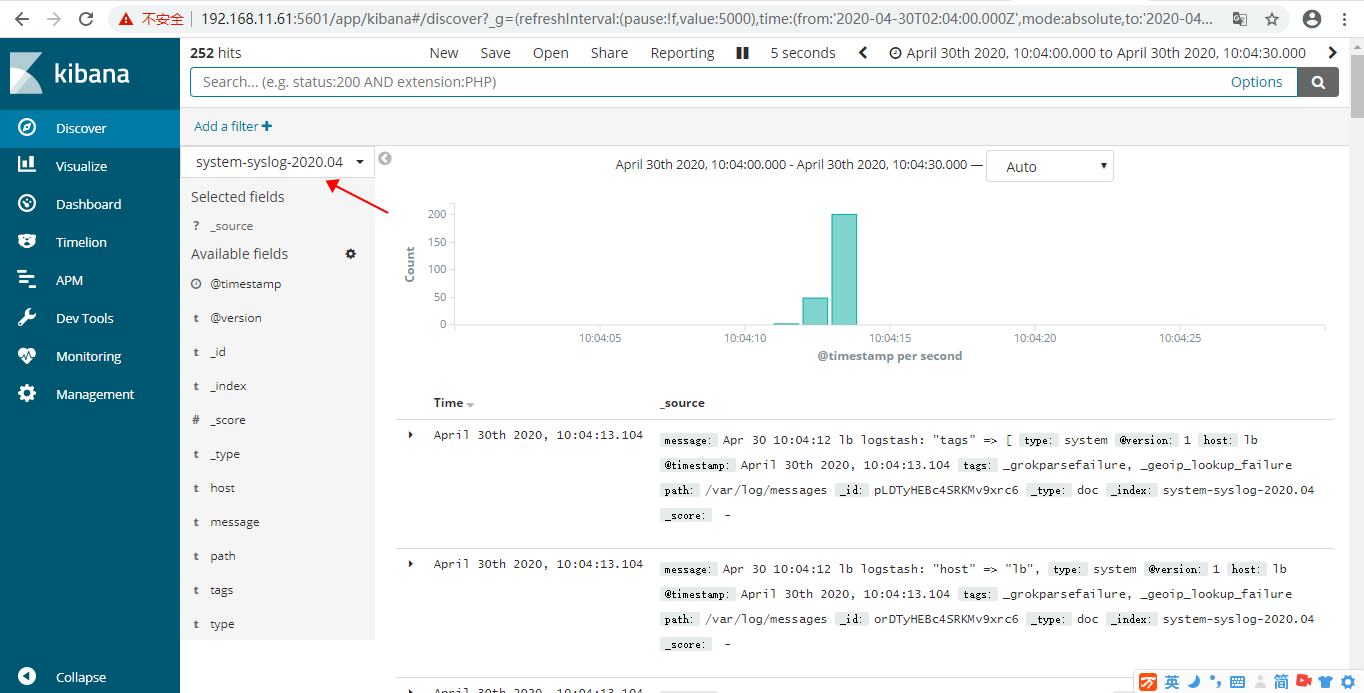
8、logstash收集nginx日志
和收集syslog一样,首先需要编辑配置文件,这一步在logstash服务器上完成:
[root@lb ~]# vim /etc/logstash/conf.d/nginx.conf input { file { # 指定一个文件作为输入源 path => "/tmp/elk_access.log" # 指定文件的路径 start_position => "beginning" # 指定何时开始收集 type => "nginx" # 定义日志类型,可自定义 } } filter { # 配置过滤器 grok { match => { "message" => "%{IPORHOST:http_host} %{IPORHOST:clientip} - %{USERNAME:remote_user} \[%{HTTPDATE:timestamp}\] \"(?:%{WORD:http_verb} %{NOTSPACE:http_request}(?: HTTP/%{NUMBER:http_version})?|%{DATA:raw_http_request})\" %{NUMBER:response} (?:%{NUMBER:bytes_read}|-) %{QS:referrer} %{QS:agent} %{QS:xforwardedfor} %{NUMBER:request_time:float}"} # 定义日志 的输出格式 } geoip { source => "clientip" } } output { stdout { codec => rubydebug } elasticsearch { hosts => ["192.168.11.61:9200"] index => "nginx-test-%{+YYYY.MM.dd}" } }
同样的编辑完配置文件之后,还需要检测配置文件是否有错:
[root@lb conf.d]# ./logstash --path.settings /etc/logstash/ -f /etc/logstash/conf.d/nginx.conf --config.test_and_exit
检查完毕之后,进入你的nginx虚拟主机配置文件所在的目录中,新建一个虚拟主机配置文件:
[root@lb ~]# cd /usr/local/nginx/conf/vhost/ [root@lb ~]# vim elk.conf server { listen 80; server_name elk.test.com; location / { proxy_pass http://192.168.77.128:5601; proxy_set_header Host $host; proxy_set_header X-Real-IP $remote_addr; proxy_set_header X-Forwarded-For $proxy_add_x_forwarded_for; } access_log /tmp/elk_access.log main2; }
配置nginx的主配置文件,因为需要配置日志格式,在 log_format combined_realip 那一行的下面增加以下内容:
[root@lb ~]# vim /usr/local/nginx/conf/nginx.conf log_format main2 '$http_host $remote_addr - $remote_user [$time_local] "$request" ' '$status $body_bytes_sent "$http_referer" ' '"$http_user_agent" "$upstream_addr" $request_time';
完成以上配置文件的编辑之后,检测配置文件有没有错误,没有的话就reload重新加载:
[root@lb ~]# nginx -t
[root@lb ~]# nginx -s reload
访问成功后,查看生成的日志文件:
[root@lb ~]# ls /tmp/elk_access.log /tmp/elk_access.log [root@lb ~]# wc -l !$ wc -l /tmp/elk_access.log 60 /tmp/elk_access.log #nginx的访问日志已经生成
[root@lb ~]# systemctl restart logstash
重启完成后,在es服务器上检查是否有nginx-test开头的索引生成:
[root@lb01 ~]# curl '192.168.11.61:9200/_cat/indices?v' health status index uuid pri rep docs.count docs.deleted store.size pri.store.size green open .kibana -8Yy0C2GQWOgNQxnAdSlug 1 1 7 0 108.4kb 54.2kb green open nginx-test-2020.04.29 SAsQdgVPTkSI82OIr0jrYg 5 1 27458 0 6.2mb 3.1mb #可以看到,nginx-test索引已经生成了
这时候可以进入kibana的web页面进行索引的配置;

9、使用beats采集日志
之前也介绍过beats是ELK体系中新增的一个工具,它属于一个轻量的日志采集器,以上我们使用的日志采集工具是logstash,但是logstash占用的资源比较大,没有beats轻量,所以官方也推荐使用beats来作为日志采集工具。而且beats可扩展,支持自定义构建。
在 192.168.11.63 上安装filebeat,filebeat是beats体系中用于收集日志信息的工具
[root@lb03 ]# cd /usr/local [root@lb03 local]# rpm -ivh filebeat-6.4.0-x86_64.rpm
安装完成之后编辑配置文件:
[root@lb03 local]# vim /etc/filebeat/filebeat.yml filebeat.prospectors: - type: log #enabled: false 这一句要注释掉 paths: - /var/log/messages # 指定需要收集的日志文件的路径 #output.elasticsearch: # 先将这几句注释掉 # Array of hosts to connect to. # hosts: ["localhost:9200"] output.console: # 指定在终端上输出日志信息 enable: true
配置完成之后,执行以下命令,看看是否有在终端中打印日志数据,有打印则代表filebeat能够正常收集日志数据:
[root@lb03 local]# filebeat -c /etc/filebeat/filebeat.yml
以上的配置只是为了测试filebeat能否正常收集日志数据,接下来我们需要再次修改配置文件,将filebeat作为一个服务启动:
[root@lb03 local]# vim /etc/filebeat/filebeat.yml #output.console: 把这两句注释掉 # enable: true # 把这两句的注释去掉 output.elasticsearch: # Array of hosts to connect to. hosts: ["192.168.11.61:9200"] # 并配置es服务器的ip地址
修改完成后启动filebeat服务
[root@lb03 local]# systemctl start filebeat
启动成功后,到es服务器上查看索引,可以看到新增了一个以filebeat开头的索引,这就代表filesbeat和es能够正常通信了:
[root@lb01 ~]# curl '192.168.11.61:9200/_cat/indices?v' health status index uuid pri rep docs.count docs.deleted store.size pri.store.size green open filebeat-6.4.0-2020.04.30 Pj8aoYx0TS68g5CKMuOWwg 3 1 8411 0 2.5mb 1.2mb
现在可以通过kibana进行添加索引,查看日志
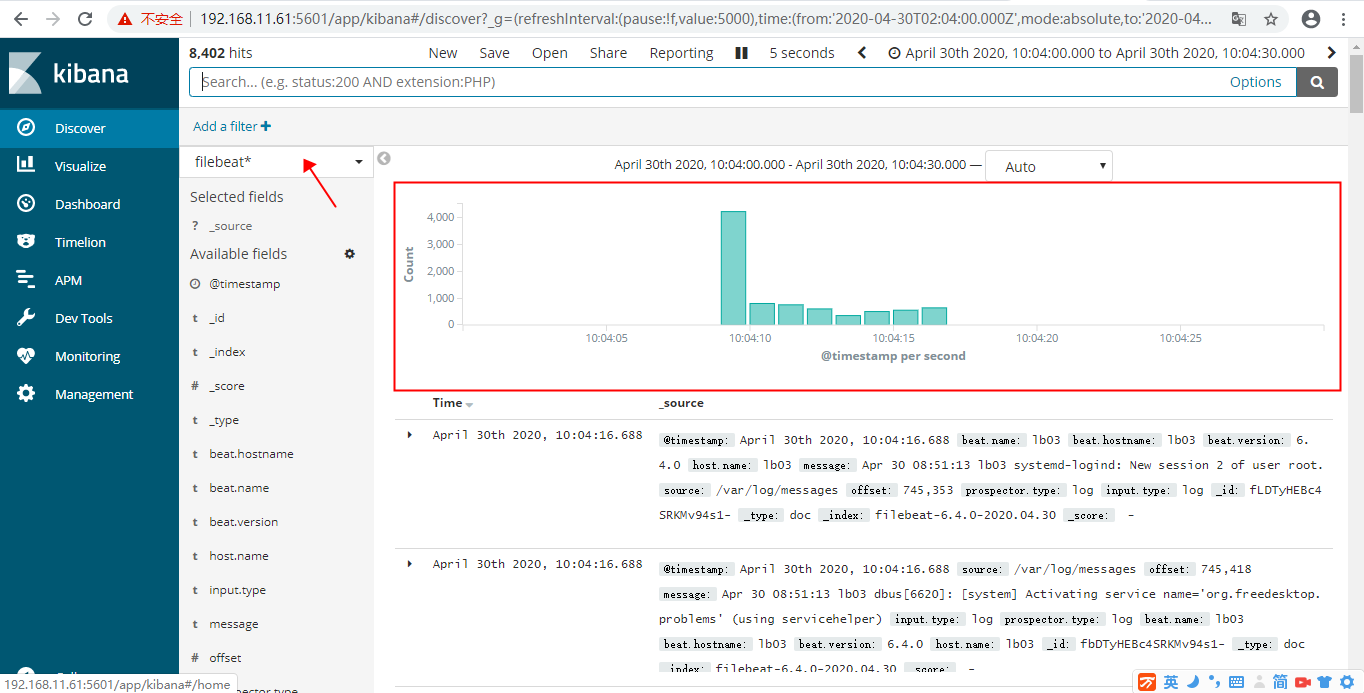
以上这就是如何使用filebeat进行日志的数据收集,可以看到配置起来比logstash要简单,而且占用资源还少。


